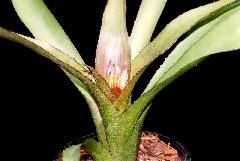
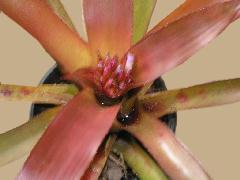
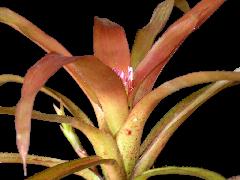
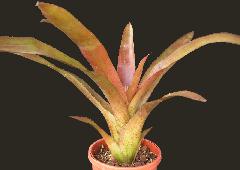
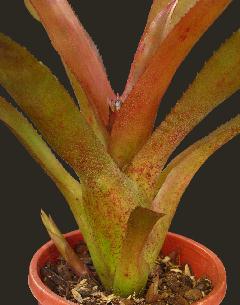
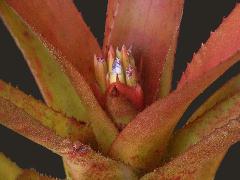
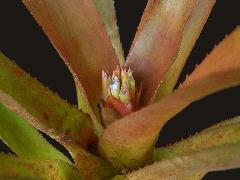
PLANT propagating by erect stolons 5-10 cm long, 0.5-0.6 cm in diameter.
LEAVES 10 to 15, subrigid in texture, suberect-arcuate;
SHEATHS elliptic, 8-9 x 5-5.5 cm, densely brown lepidote on both sides, green;
BLADES linear-lanceolate, slightly canaliculate and inconspicuously narrowed toward base, 20-40 x 3-3.5 cm, densely and minutely white-lepidote abaxially, subdensely and inconspicuously white-lepidote to glabrescent adaxially, green to reddish-purple, apex acute and apiculate, apiculus ca. 4 mm long, the inner ones becoming slightly reddish-purple near the base at anthesis in contrast to the color of the distal half of the blades, margins subdensely spinulose, spines ca. 1 mm long;
SCAPE 5-7 cm long, ca. 5 mm in diameter, whitish, brown-lepidote, completely covered by leaf-sheaths;
SCAPE BRACTS narrowly ovate-lanceolate, acuminate, suberect, distinctly exceeding the internodes, slightly exposing the scape, densely serrulate, brown-lepidote on both sides, greenish to reddish toward apex.
INFLORESCENCE subcorymbose, oblong-elliptic-capitate, inconspicuously tripinnate at base, barely to distinctly visible above the rosette but not elevated above it, ca. 30 mm long, 25-40 mm in diameter;
PRIMARY BRACTS ovate, suberect, 30-40 x 25 mm, sparsely brown-lepidote abaxially, with entire trichomes, white-lepidote adaxially toward apex, with fimbriate trichomes, reddish, apex acute, margins sub entire to spinulose near the apex, the basal ones equalling to slightly exceeding the fascicles;
FASCICLES ca. 5, ca. 30 mm long (excluding the petals), 15-20 mm wide, subflabellate, peduncle short and stout, with 4 to 7 flowers;
FLORAL BRACTS ovate to oblong-ovate, apex broadly acute and minutely apiculate, slightly cucullate, erect, 17-20 x 8-9 mm, subentire or remotely spinulose at apex, slightly carinate, membranaceous, reddish, sparsely white-lepidote abaxially, with fimbriate trichomes, subglabrous adaxially, about equalling 1/2 to 2/3 of sepal length.
FLOWERS ca. 38 mm long, sessile;
SEPALS subsymmetrical, elliptic, apex acute to subacute and apiculate, 15-17 x 6 mm, connate at base for ca. 5 mm, glabrous, greenish to reddish, ecarinate;
PETALS linear-spatulate, 25-29 x 6 mm long, connate for 14-15 mm, apex broadly acute and apiculate, white except for the lilac apex, sub erect at anthesis, becoming slightly twisted-erect and reddish after anthesis, bearing two tenuous longitudinal callosities equalling the free portion of the filaments;
ANTHERS oblong, ca.4 mm long, apex apiculate, fixed at the middle;
STIGMA ellipsoid, white, lobes with minutely crenulate margins;
OVARY ellipsoid, 9-12 mm long, ca. 5 mm in diameter, white, glabrous.
FRUITS unknown.
TYPE
Rio de Janeiro, Rio de Janeiro, Jacarepagui, Vargem Pequena, 7 Jan. 1985, L. K. Correia de Araujo s. n., cult. E. Leme 625. Holotype: HB. Isotype: RB. Clonotype:WU.
ETYMOLOGY
Canistropsis correia-araujoi is named in honor of Luiz K. Correia de Araujo, a pioneer of organized bromeliad cultivation in Brazil. Lulu Correia de Araujo, as he is known to his friends, has introduced many new bromeliad species to horticulture, some of which have tremendous ornamental value, such as Aechmea correia-araujoi and Hohenbergia correia-araujoi.
DISCUSSION
Within the genus Canistropsis, C. correia-araujoi is unquestionably the most disparate taxon, in terms of morphology, when compared to the other species. The absence of additional collections of this bromeliad (see next topic) makes our analysis all the more difficult, besides the fact that several morphological traits shown by this species do not follow the normal pattern of this genus, nor is there close affinity to Nidularium or Neoregelia. Though compatible with the basic conceptual lines of Canistropsis, important dissonant elements are as follows:
a) leaves stiffer than usual, but not coriaceous;
b) central rosette leaves becoming slightly reddish purple at anthesis in contrast to the outer leaves;
c) petals connate for over half their length.
Both the stoloniferous habit and the inflorescence structure conform to that of Canistropsis, but leaf texture and color are more closely associated with Neoregelia. Conversely, the corolla with its well-developed basal tube is typical of Nidularium. It is therefore possible that this taxon is a product of natural bigeneric hybridization between sympatric species of the nidularioid complex - and this is not an isolated phenomenon (Leme, unpubl. data). At least three species that might have played a role in this hybridization process are found in the area where C. correia-araujoi was collected: C. microps (see description below), Nidularium procerum (nonstoloniferous, leaves subrigid and blue corolla, distinctly gamopetalous) and Neoregelia indecora (stoloniferous, leaves subrigid, central leaves turning red at anthesis, and blue petals).
Stigma morphology studies have also raised the question as to the hybrid origin of this taxon as is demonstrated by the disruption of stigma blade development (Chapter 7). However, before deciding whether the hypothesis is correct or not, and which species would have contributed to hybrid formation, I think it wise to do more laboratory and field studies aimed at resolving this very issue, a course of action which was not possible during the course of this revision.
DISTRIBUTION & HABITAT
This species is known only from the type collection from remnant forests in the Jacarepagua area, Rio de Janeiro. There have been no new collections and therefore very little is known about the geographic distribution of the taxon. Canistropsis correia-araujoi flowers in cultivation during December and January in Rio de Janeiro; it is represented in Brazilian horticulture and overseas by the clone that produced the holotype. In theory, it may occur in the Tijuca National Park, the Grajau Forest Reserve or the Pedra Branca State Park, public conservation units near the site where the taxon was found for the first and only time.